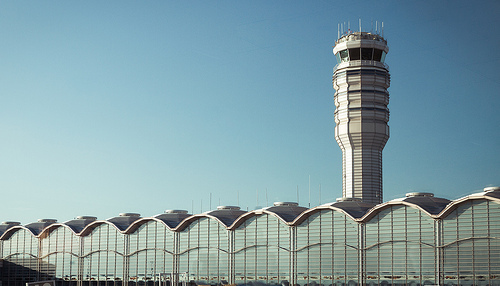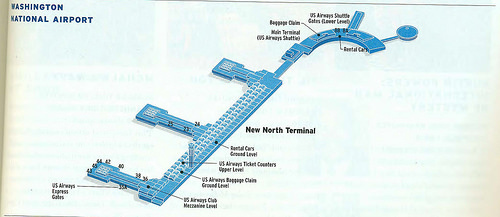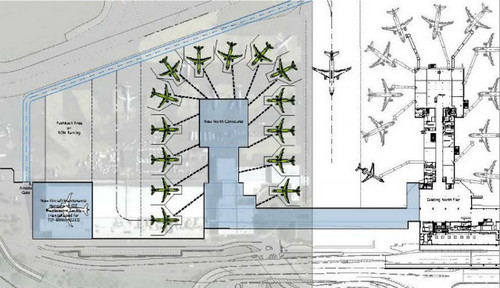Building of the Week: Terminal B/C at National airport
Ronald Reagan Washington National airport turned 75 years old this month, having served the region since president Franklin Delano Roosevelt welcomed the first American Airlines DC-3 in 1941. Today, terminal B/C, which opened in 1997, is the focal point of the airport and an instantly recognizable part of the region’s architectural heritage.
The most striking elements of terminal B/C, which was designed by Cesar Pelli, are its domes. Considered “Jeffersonian” in their design, each of the 54 in the terminal building is a modular, 45-foot square bay made of steel with a glass oculus at their center, according to National Airport Terminal, Pelli’s book on the project.
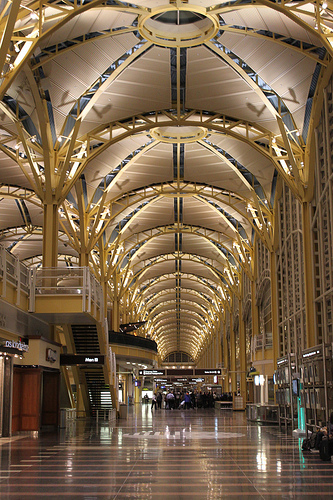
Each Jeffersonian dome in terminal B/C is 45 feet square with a glass oculus at its center. Photo by Brian Allen.
The domes serve as a connection between the terminal and the “civic architecture of Washington DC,” which is purposely visible through the floor-to-ceiling glass wall that faces the aircraft ramp and the District, says Pelli.
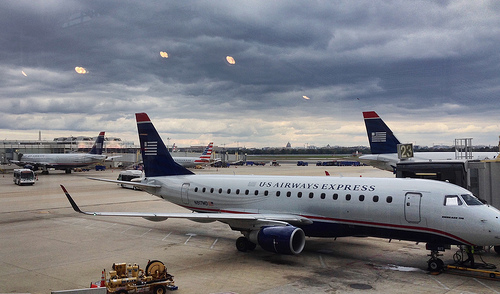
Travellers can see the US capitol, other monuments and the Potomac River through terminal B/C’s floor-to-ceiling glass wall. Photo by the author.
Pelli placed all of the terminal’s functional elements, like ticket counters, baggage belts and restrooms, on the landside of the building to allow for the glass wall.
The domes also feature in each of terminal B/C’s three piers, with nine atop the atriums at the end of each concourse.
”[The terminal] has a kind of industrialized Gothic quality inside,” wrote architecture critic Paul Goldberger in the book. “The architect has managed to combine the lightness of late Gothic architecture with the tensile quality of twentieth-century modernism.”
He notes that the design benefitted from the Metropolitan Washington Airport Authority’s (MWAA) desire for a terminal that had sufficient “aesthetic stature” to serve as a gateway to the US capital.
A long-needed upgrade
Terminal B/C was a long-overdue solution to the problem that was National airport. By the 1980s, the airport’s three terminals—the main terminal (terminal A today), north terminal and commuter terminal (see a map here)—were outdated and overcrowded.
“It is a major horror story of modern planning,” James Murphy, then head of airport policy for the then Air Transport Association and a former manager of National airport, told The Washington Post in June 1986. “You can’t overstate the problems. It has the most severe facility constraints per square foot of any airport I have ever seen.”
Work on a new master plan officially began in 1982, MWAA documents show. However, it was not until the formation of the airport authority in 1987 that the project moved into high gear.
MWAA approved a master plan that included terminal B/C in March 1988, less than a year after its formation. The first project, the demolition of hangar one and construction of a new parking garage, began that July.
A key consideration for the project was access from the Metro. When the station opened in 1977, it was only somewhat convenient for passengers flying out of the commuter or north terminals and a long walk through parking lots to the main terminal, which handled the bulk of airport traffic. Terminal B/C was sited where it is and designed to eliminate this inconvenience and make it easy for travellers to access the building from the rail system.
In 1989, Pelli was hired to design the new terminal that at the time was expected to cost about $200 million and open in 1994.
The same year, an interim terminal opened on the north side of National to accommodate passengers displaced by the demolition of the commuter terminal and old north terminal during construction.
The terminal project encountered a setback in 1990. As it was laid out, the new building would obstruct the view of the threshold of one of National airport’s three runways from the old control tower atop the main terminal. The issue was rectified by the addition of a new tower to terminal B/C.
Pelli unveiled four potential designs for the terminal in early 1992. Later that year, MWAA selected the one dubbed “Jeffersonian Domes” but was forced to scale down the plans due to airline and congressional concerns about rapidly rising costs that had nearly doubled to $400 million by that time.

The four proposed designs for terminal B/C at National airport, the ultimate Jeffersonian dome design is in the bottom right. Image from National Airport Terminal by Cesar Pelli.
Construction began on terminal B/C in November 1993 and took nearly four years, with the facility opening on July 27, 1997 —three years late and about $250 million more than originally expected.
Adapting for more passengers
National airport again faces congestion issues. Passenger traffic increased by nearly six million to 23 million from 2009 to 2015, placing strain on facilities that were designed to handle roughly 17 to 18 million people annually.
MWAA plans to build a new commuter concourse on the north side of the airport replacing gate 35X, which is the bain of many passengers flying on small regional aircraft. The concourse will replace 14 remote aircraft parking positions with the same number of gates with jetways.
The concourse has been planned since at least 1998, when the authority approved a regional concourse on the same site for then US Airways. The project was cancelled later the same year as the airline faced financial difficulties.
MWAA also plans to move national hall — the hall with Pelli’s floor-to-ceiling glass wall overlooking the tarmac and capital — in terminal B/C behind security in order to reduce chokepoints at the entrance to each pier and ease passenger connections between the concourses.
The new concourse and reconfiguration of national hall will be the first major changes to Pelli’s iconic terminal B/C.

